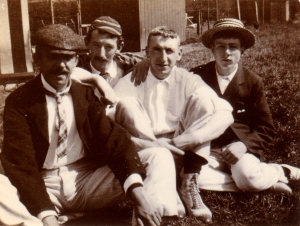(This post is dedicated to Vickie, Erica, Ashley, Melissa M., Kate, Shamima and Melissa MC., our class-A Administrative Professionals at Production Solutions).
 After a stressful, short commute to my office involving side-swiping teenagers texting while driving, the executive ruminating over something that causes him to not see the light turn green (had to honk) and the young lady who felt compelled to tailgate me all the way to the office, I finally arrive, unscathed and in 1 piece, only to discover that I forgot to wear a tie for a meeting as well as to take my money clip (sitting in a bowl in my bedroom). Thankfully, I walked in to the welcoming smile and warm greeting of my front office staff and suddenly all the stress melted into the background.
After a stressful, short commute to my office involving side-swiping teenagers texting while driving, the executive ruminating over something that causes him to not see the light turn green (had to honk) and the young lady who felt compelled to tailgate me all the way to the office, I finally arrive, unscathed and in 1 piece, only to discover that I forgot to wear a tie for a meeting as well as to take my money clip (sitting in a bowl in my bedroom). Thankfully, I walked in to the welcoming smile and warm greeting of my front office staff and suddenly all the stress melted into the background.
How can anyone maintain a frown or bad attitude when the first things you see are two smiling people wishing you the best day ever?! If they have anything to do with it, I know it will be a good day!
And how about one that hands you a tie…she just happened to have it in her drawer (“break in case of emergency”).
Full disclosure: I started my direct marketing career after two uneventful jobs after college, in a crazy-busy fundraising firm. It was a company that believed everyone in the company should do a little front office work, from time-to-time.
“From time-to-time” for me became half-my-time as the full-time reception one day decided to hand one of the partners two Valiums when he asked for “two yellow tablets.” (He really wanted yellow writing tablets)!
Not smart.
In any event, I became the front office for a couple of years… half-time. And guess what? I loved it.
I loved answering the phone on the first ring. I loved greeting our wonderful suppliers and clients representing causes that mattered by their name sans waiting for them to tell me. I loved being a team player and slipping a note to one of the partners suggesting that he “take this call…” and him thanking me afterwards. I loved greeting and thanking the UPS man, the FEDEX woman and the mail carrier for their work.
Most of all I loved how I made all my fellow employees feel at the beginning of the day as I greeted them with a smile, a fresh pot of coffee and, on some days with CINNABONS. (I was goooooood).
My childlike optimism that I bestowed upon my colleagues was due to being basically a simple man, always happy that “God woke me up” and blessed with a whole lot of energy (back then) and loving my job.
Looking back on my days as a first-impression specialist, I know that my style in which I managed the front office really set the tone and temper of the day with my colleagues and led to (many a time) disarming an angry client or supplier to having a responsible conversation with the grateful account executive. 🙂
Fast forward to Production Solutions… 27 years ago when we opened our doors as a production management and direct marketing firm; there was, and always will be, a beautiful soul and loving front office person ready for an honest greeting of positivity and hope, ready to represent our company and our mission proudly.
I remain a stalwart regarding certain front office protocols:
1. I steadfastly support a RESPONSIVE, WARM, REAL, LIVE VOICE when calling into Production Solutions.
2. I steadfastly support the dignity, the respect, the intimacy and caring my company demonstrates to all who visit our place, by having a wonderful soul sitting in the front and receiving all our visitors.
3. I steadfastly support one of the many layers of corporate branding that “a real” front office offers and value how it educates inquiries on what we do and who we are.
Many of my industry colleagues have gone to a virtual or digital front desk and with that I question whether they’ve compromised their uniqueness in order to save money.
Suffice it to say we won’t be testing that notion, no matter how economical it may be. From the feedback I get at least once a week from our suppliers or clients…I know we’ve got a good thing going.
Now mind you…my front office won’t be giving out any Valium anytime soon (no matter how much you may need it!), but we will have laptops, private rooms, pens and yellow writing tablets available for any visitor in need.
“Good morning, Production Solutions; How may I help you?” It is truly our pleasure to make your day.
– George
____________________________________________________

George Lizama, a founder of Production Solutions and its CEO and chief marketing officer, has spent over 30 years in production management. A recognized leader in the fundraising industry, George served as president of the Direct Marketing Association of Washington (DMAW) in 2010 and received its Distinguished Achievement Award in 2006. In 2008, he received a Washington Business Journal Philanthropy Award for CEO Leadership, partly in recognition of his longtime support of Northern Virginia Family Service, of which he is a director.
















